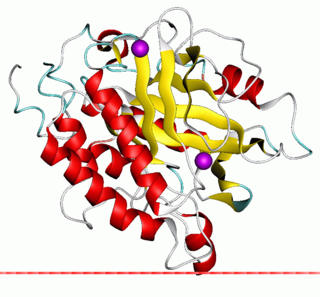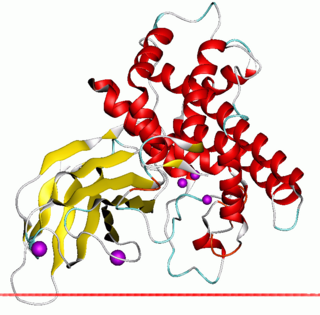This page is based on this
Wikipedia article Text is available under the
CC BY-SA 4.0 license; additional terms may apply.
Images, videos and audio are available under their respective licenses.

A phospholipase is an enzyme that hydrolyzes phospholipids into fatty acids and other lipophilic substances. There are four major classes, termed A, B, C and D, which are distinguished by the type of reaction which they catalyze:

Phospholipases A2 (PLA2s) EC 3.1.1.4 are enzymes that cleaves fatty acid in position two of phospholipids, hydrolyzing the bond between the second fatty acid “tail” and the glycerol molecule. This particular phospholipase specifically recognizes the sn-2 acyl bond of phospholipids and catalytically hydrolyzes the bond, releasing arachidonic acid and lysophosphatidic acid. Upon downstream modification by cyclooxygenases or lipoxygenases, arachidonic acid is modified into active compounds called eicosanoids. Eicosanoids include prostaglandins and leukotrienes, which are categorized as anti-inflammatory and inflammatory mediators.

Phosphoinositide phospholipase C (PLC) is a family of eukaryotic intracellular enzymes that play an important role in signal transduction processes. These enzymes belong to a larger superfamily of Phospholipase C. Other families of phospholipase C enzymes have been identified in bacteria and trypanosomes. Phospholipases C are phosphodiesterases.
Phospholipase D (PLD) is an enzyme of the phospholipase superfamily. Phospholipases occur widely, and can be found in a wide range of organisms, including bacteria, yeast, plants, animals, and viruses. Phospholipase D’s principal substrate is phosphatidylcholine, which it hydrolyzes to produce the signal molecule phosphatidic acid (PA), and soluble choline. Plants contain numerous genes that encode various PLD isoenzymes, with molecular weights ranging from 90-125 kDa. Mammalian cells encode two isoforms of phospholipase D: PLD1 and PLD2. Phospholipase D is an important player in many physiological processes, including membrane trafficking, cytoskeletal reorganization, receptor-mediated endocytosis, exocytosis, and cell migration. Through these processes, it has been further implicated in the pathophysiology of multiple diseases: in particular the progression of Parkinson’s and Alzheimer’s, as well as various cancers.
Glycosylphosphatidylinositol phospholipase D (EC 3.1.4.50, GPI-PLD, glycoprotein phospholipase D, phosphatidylinositol phospholipase D, phosphatidylinositol-specific phospholipase D) is an enzyme with systematic name glycoprotein-phosphatidylinositol phosphatidohydrolase. This enzyme catalyses the following chemical reaction

Phospholipase B, also known as lysophospholipase, is an enzyme with a combination of both PLA1 and PLA2 activities; that is, it can cleave acyl chains from both the sn-1 and sn-2 positions of a phospholipid. In general, it acts on lysolecithin.

Clostridium perfringens alpha toxin is a toxin produced by the bacterium Clostridium perfringens and is responsible for gas gangrene and myonecrosis in infected tissues. The toxin also possesses hemolytic activity.

Phospholipase A1 encoded by the PLA1A gene is a phospholipase enzyme which removes the 1-acyl. Phospholipase A1 is an enzyme that resides in a class of enzymes called phospholipase that hydrolyze phospholipids into fatty acids. There are 4 classes, which are separated by the type of reaction they catalyze. In particular, phospholipase A1 (PLA1) specifically catalyzes the cleavage at the SN-1 position of phospholipids, forming a fatty acid and a lysophospholipid.
PAF acetylhydrolase is an enzyme that catabolizes platelet-activating factor. There are multiple enzymes with this function:
In enzymology, a glycosylphosphatidylinositol diacylglycerol-lyase is an enzyme that catalyzes the chemical reaction

In enzymology, a phosphatidylinositol diacylglycerol-lyase is an enzyme that catalyzes the chemical reaction
In enzymology, a lysophospholipase (EC 3.1.1.5) is an enzyme that catalyzes the chemical reaction
In enzymology, a phosphatidylinositol deacylase (EC 3.1.1.52) is an enzyme that catalyzes the chemical reaction

1-Phosphatidylinositol-4,5-bisphosphate phosphodiesterase gamma-2 is an enzyme that in humans is encoded by the PLCG2 gene.

Phospholipase C (PLC) is a class of membrane-associated enzymes that cleave phospholipids just before the phosphate group (see figure). It is most commonly taken to be synonymous with the human forms of this enzyme, which play an important role in eukaryotic cell physiology, in particular signal transduction pathways. There are thirteen kinds of mammalian phospholipase C that are classified into six isotypes (β, γ, δ, ε, ζ, η) according to structure. Each PLC has unique and overlapping controls over expression and subcellular distribution. Activators of each PLC vary, but typically include heterotrimeric G protein subunits, protein tyrosine kinases, small G proteins, Ca2+, and phospholipids.

In molecular biology, zinc-dependent phospholipases C is a family of bacterial phospholipases C enzymes, some of which are also known as alpha toxins.
N-Acylphosphatidylethanolamines (NAPEs) are hormones released by the small intestine into the bloodstream when it processes fat. NAPEs travel to the hypothalamus in the brain and suppress appetite. This mechanism could be relevant for treating obesity.

A lipase is any enzyme that catalyzes the hydrolysis of fats (lipids). Lipases are a subclass of the esterases.








